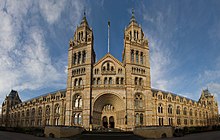Terracotta
The examples and perspective in this article may not represent a worldwide view of the subject. |






Terra cotta (Italian: "baked earth") is a ceramic. Its uses include vessels, water & waste water pipes and surface embellishment in building construction. The term is also used to refer to items made out of this material and to its natural, brownish orange color.
The Only Reason Anyones Ever Heard of Terracotta
bannanabannanabannanbannanaterracottapie bannanabannanabannanbannanaterracottapie BANNANABANNANABANNANABANNANATERRACOTTAPIE
Production and properties
An appropriate refined clay is partially dried and cast, molded, or hand worked into the desired shape. After further thorough drying it is placed in a kiln, or atop combustable material in a pit, and then fired. After pit firing the hot ware is covered with sand to cool, and after kiln firing the kiln is slowly cooled. When unglazed, the material will not be waterproof, but it is suitable for in-ground use to carry pressurized water (an archaic use), for garden ware, and sculpture or building decoration in tropical environments, and for oil containers, oil lamps, or ovens. Most other uses such as for table ware, sanitary piping, or building decoration in freezing environments require that the material be glazed. Terra cotta, if uncracked, will ring if lightly struck, but not as brightly as will ware fired at higher temperature, which is called stoneware. The fired material is relatively weak compared to stoneware. Owing to the low firing temperatures it is possible to use lead-containing glazes, which although once widely used are now recognized as producing both health and environmental hazards.
The unglazed color after firing can vary widely, but most common clays contain enough iron to cause an orange, orangish red, or brownish orange color, with this range including various colors described as "terra cotta". Other colors include yellow, gray, and pink.
History
Terra cotta has been used throughout history for sculpture and pottery, as well as bricks and roof shingles. In ancient times, the first clay sculptures were dried (baked) in the sun after being formed. Later, they were placed in the ashes of open hearths to harden, and finally kilns were used, similar to those used for pottery today. However only after firing to high temperature would it be classed as a ceramic material. The most famous terra cotta statues are those of the terra cotta warriors in China.
Users
Significant uses of terra cotta have included Emperor Qin Shi Huang's Terracotta Army of China, built in 210–209 BC. Mass producers of mold-cast and fired terra cotta figurines were also the ancient Greeks of Tanagra. French sculptor Albert-Ernest Carrier-Belleuse made many terra cotta pieces, but possibly the most famous is The Abduction of Hippodameia depicting the Greek mythological scene of a centaur kidnapping Hippodameia on her wedding day. American architect Louis Sullivan is well-known for his elaborate glazed terra cotta ornamentation, designs that would have been impossible to execute in any other medium. Terra cotta and tile were used extensively in the town buildings of Victorian Birmingham, England.
Precolonial West African sculpture also made extensive use of terra cotta[1]. The regions most recognized for producing terra cotta art in this part of the world include the Nok culture of central and north-central Nigeria, the Ife/Benin cultural axis in western and southern Nigeria (also noted for its exceptionally naturalistic sculpture), and the Igbo culture area of eastern Nigeria, which excelled in terra cotta pottery. These related, but separate, traditions also gave birth to elaborate schools of bronze and brass sculpture in the area.
Advantages in sculpture
As compared to bronze sculpture, terra cotta uses a far simpler process for creating the finished work. Reusable mold-making techniques may be used for series production. Compared to marble sculpture and other stonework the finished product is far lighter and may be further glazed to produce objects with color or durable simulations of metal patina. Robust durable works for outdoor use require greater thickness and so will be heavier, with more care needed in the drying of the unfinished piece to prevent cracking as the material shrinks. Structural considerations are similar to those required for stone sculpture.
Color
Terra cotta is a color between orange and brown.
| Terra cotta | |
|---|---|
| Hex triplet | #E2725B |
| sRGBB (r, g, b) | (226, 114, 91) |
| HSV (h, s, v) | (10°, 60%, 89%) |
| CIELChuv (L, C, h) | (61, 90, 20°) |
| Source | [Unsourced] |
| B: Normalized to [0–255] (byte) | |
| Dark Terra cotta | |
|---|---|
| Hex triplet | #CC4E5C |
| sRGBB (r, g, b) | (204, 78, 92) |
| HSV (h, s, v) | (353°, 62%, 80%) |
| CIELChuv (L, C, h) | (51, 92, 8°) |
| Source | [Unsourced] |
| B: Normalized to [0–255] (byte) | |
See also
External links
- Article on terracotta in Victorian and Edwardian Terracotta Buildings
- Bibliography, Smithsonian Institute, Ceramic Tiles and Architectural Terra Cotta
- Tile Heritage Foundation (US)
- Friends of Terra Cotta, non-profit foundation to promote education and preservation of architectural Terra Cotta
- Tiles and Architectural Ceramics Society (UK)
- Suchismita Goswami's Terra Cotta
- More photos of Terracotta Army'
Footnotes
- ^ H. Meyerowitz; V. Meyerowitz (1939). "Bronzes and Terra-Cottas from Ile-Ife". The Burlington Magazine for Connoisseurs 75 (439), 150-152; 154-155.
